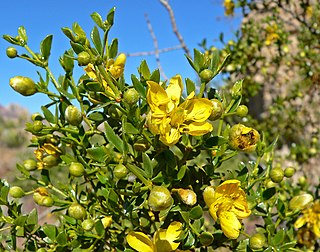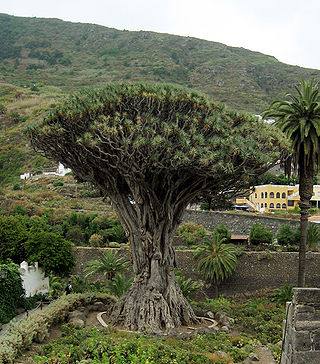
Zygophyllaceae is a family of flowering plants that contains the bean-caper and caltrop. The family includes around 285 species in 22 genera.

Dracaena is a genus of about 200 species of trees and succulent shrubs. The formerly accepted genera Pleomele and Sansevieria are now included in Dracaena. In the APG IV classification system, it is placed in the family Asparagaceae, subfamily Nolinoideae. It has also formerly been separated into the family Dracaenaceae or kept in the Agavaceae.

Podophyllum is a genus of flowering plant in the family Berberidaceae, native from Afghanistan to China, and from southeast Canada to the central and eastern United States. The genus was first described by Carl Linnaeus in 1753.

Valeriana is a genus of flowering plants in the family Caprifoliaceae, members of which may be commonly known as valerians. It contains many species, including the garden valerian, Valeriana officinalis. Valeriana has centers of diversity in Eurasia and South America, and is represented by native species on all continents except Antarctica.

Fagonia is a genus of wild, flowering plants in the caltrop family, Zygophyllaceae, having about 34 species. The latest reorganization of the genus took place in 2018 when systematists Christenhusz & Byng, Royal Botanical Gardens, Kew (UK) included Fagonia spp.. along with several other Zygophyllum genera, into a new genus named "Zygophyllum L." Species occurring in the US are commonly referred to as fagonbushes. The distribution of the genus includes parts of Africa, the Mediterranean Basin, the Mid-East, India, and parts of North & South America. Fagonia species have been used ethnobotanically by traditional practitioners under Ayurvedic and other TM healing regimes for many maladies. Species occur in deserts, dry washes, ditches and on rocky outcrops, including at altitude.

Staphylea, called bladdernuts, is a small genus of 10 or 11 species of flowering plants in the family Staphyleaceae, native to temperate regions of the Northern Hemisphere. The highest species diversity is in China, where four species occur.

Sansevieria is a historically recognized genus of flowering plants, native to Africa, notably Madagascar, and southern Asia, now included in the genus Dracaena on the basis of molecular phylogenetic studies. Common names for the 70 or so species formerly placed in the genus include mother-in-law's tongue, devil's tongue, jinn's tongue, bow string hemp, snake plant and snake tongue. In the APG III classification system, Dracaena is placed in the family Asparagaceae, subfamily Nolinoideae. It has also been placed in the former family Dracaenaceae.

Cochlospermum is a genus of trees in the Bixaceae family; some classifications place this genus in the family Cochlospermaceae. It is native to tropical regions of the world, particularly Latin America, Africa, the Indian Subcontinent, and Australia.

Olax is a plant genus in the family Olacaceae. It includes 52 species native to the tropics of South America, Africa, Asia, and Australia. The name derives from the Latin, olax (malodorous), and refers to the unpleasant scent of some of the Olax species. Olax is an Old World genus represented by several climbers, some species have leaves and fruits smelling of garlic such as Olax subscorpioidea and Olax gambecola, seeds of the latter are used as condiments in parts of West Africa. In India Olax nana is well known as one of the first species to emerge after forest fires, the shoots growing directly from buried roots.

Zygophyllum is the type genus of the flowering plant family Zygophyllaceae. The generic name is derived from the Greek words ζυγόν (zygon), meaning "double", and φυλλον (phyllon), meaning "leaf". It refers to the leaves, each of which have two leaflets.

Ayenia is a genus of flowering plants in the mallow family, Malvaceae. It includes 216 species of subshrubs, shrubs, small trees, and lianas. They are native to the tropical Americas and southwestern United States, tropical Africa, and tropical Asia.

Urceolina is a genus of South American plants in the amaryllis family native to Bolivia, Brazil, Colombia, Costa Rica, Ecuador, Guatemala, Panama, and Peru. It has also been introduced to many South and Central American states, as well as India and Sri Lanka. The formerly accepted genera Eucharis and Caliphruria are now regarded as synonyms of this genus. Many species of this genus share the common name Amazon lily.
Cipuropsis is a genus of flowering plant in the family Bromeliaceae, native to the Caribbean, southern Central America and northwestern South America. The genus was first described by Ule in 1907.

Dracaena suffruticosa, synonym Sansevieria suffruticosa is a species of Dracaena native to eastern Africa, from Ethiopia to Malawi. The first description of the species was made in 1915 by N. E. Brown.

Zygophyllum stapffii, synonym Tetraena stapffii, is a species of flowering bush endemic to Namibia. As of January 2025, the specific epithet was sometimes spelt with a single f, i.e. stapfii, but the International Plant Names Index spells it with double f.
Morisonia is a genus of flowering plants in the family Capparaceae, found across the Americas from the United States to Argentina. They are typically shrubs or small trees. The genus was recently enlarged with New World Capparis species due to existing taxonomic instability.
Augea is a possible monotypic genus of flowering plants in the family Zygophyllaceae. Its only species is Augea capensis, native to Namibia and the western Cape Province of South Africa. The genus and species were first described by Carl Peter Thunberg in 1794.
Josemania is a genus of flowering plant in the family Bromeliaceae, first described in 2016.
Zygophyllum zilloides is a species of flowering plant in the torchwood family Zygophyllaceae, native to the western Sahara desert. A subshrub, its fruits are loculicidal capsules.

Zygophylloideae is a subfamily of the family Zygophyllaceae. The subfamily comprises about 180 species of shrubs, subshrubs and herbs, found throughout arid parts of the Palaeotropics and into North and South America. As of February 2025, the division of the subfamily into genera is disputed, with between four and seven genera accepted by different sources.














